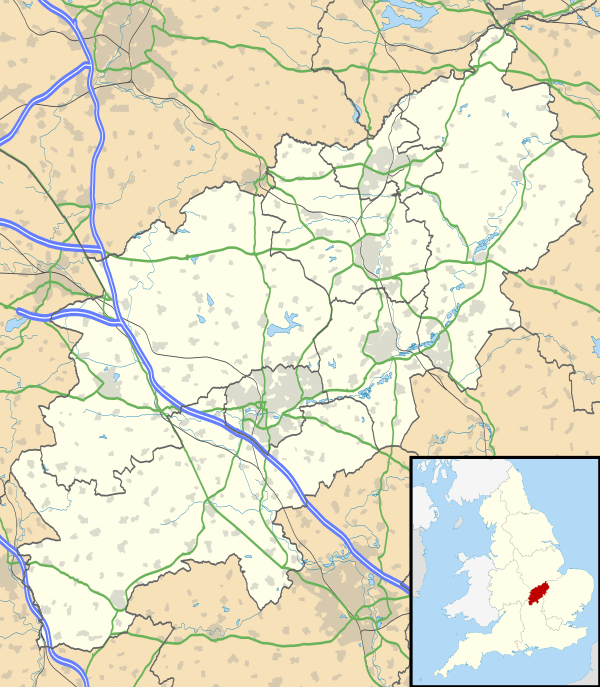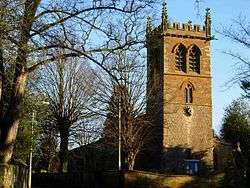Gayton, Northamptonshire
| Gayton | |
 Gayton Manor: A splendid Tudor manor house, built by Sir Francis Tanfield |
|
 Gayton |
|
| Population | 544 (2011 census) |
|---|---|
| OS grid reference | SP704547 |
| – London | 69 miles (111 km) |
| Civil parish | Gayton |
| District | South Northamptonshire |
| Shire county | Northamptonshire |
| Region | East Midlands |
| Country | England |
| Sovereign state | United Kingdom |
| Post town | NORTHAMPTON |
| Postcode district | NN7 |
| Dialling code | 01604 |
| Police | Northamptonshire |
| Fire | Northamptonshire |
| Ambulance | East Midlands |
| EU Parliament | East Midlands |
| UK Parliament | Current: Northampton South From 2010 General Election: Daventry |
|
|
Coordinates: 52°11′06″N 0°58′26″W / 52.185°N 0.974°W


Gayton is a rural village 5 miles (8 km) from Northampton town centre in South Northamptonshire. The population of the civil parish at the 2011 census was 544.[1] It is situated on a hill close to the larger villages of Bugbrooke, Milton Malsor and Blisworth, with a linked public footpath network.
History
Sited near Watling Street, the ancient way from the ports of Kent to Wroxeter, Gayton was not recorded in the Domesday Book survey of 1086 but was probably the unnamed settlement in the Hundred of Towcester held by the knight Sigar of Chocques, who came from the village of that name near Béthune in the north of France. By 1162 it had passed to his relation Robert V of Béthune, being inherited in turn by his eldest son Robert VI, by his second son William II, by William's eldest son Daniel and then by Daniel's younger brother. This was Robert VII, who in 1242 sold the manor along with virtually all his other English properties to Robert of Guines. In 1248 Robert sold Gayton to Ingram of Fiennes, who in 1270 passed it to Michael of Northampton, a cleric.[2]
Sir Philip de Gayton (d.1316),[3] had a daughter named Scholastica de Gayton (d.1354)[3] and she was said to have murdered her husband. She had a sister called Julianna who bore a child known as Mabila. Julianna later met her fate by burning as it was decided that she was a witch. The facts of this tale have become somewhat confused over the centuries but the de Gayton tombs are in the village church.[4]
Sir Francis Tanfield(d.1558),[3] governor of Lord Falkland’s Colony of Newfoundland, Canada 1623–25 built the Manor House in the village in the early 17th century and has some similarity to Sir Thomas Tresham's at Lyveden New Bield. It is probable that Sir Francis was the son of Clement Tanfield and his wife, Anne, of Gayton. He was born in 1565 and was knighted in July 1603 and, in September, accompanied the new ambassador, Lord Spencer, to the court of the Duke of Württemberg, now part of southern Germany. The Hughes of Gwerclas family, a Welsh family of native royal blood, resided at the Manor House during the late 18th Century.
There were three brickyards in the parish,[4] now all gone and filled in with domestic refuse. The parish was also a source of ironstone particularly the area bordering Tiffield.
Governance
The village has a Parish Council. The local district council is South Northamptonshire[5] where Gayton is in Harpole and Grange ward together with the villages of Milton Malsor, Rothersthorpe, Harpole and Kislingbury and elects two members.
Facilities
There is a church, dedicated to St Mary the Virgin. The base of the tower and font are Norman[4] though the upper part of the tower 19th century. The church contains six misericords dating from the 14th and 15th century, unusually, some of these have been modified at a later date, possibly by foreign carvers. There are monuments to Sir Philip and Scholastica de Gayton, Sir Francis Tanfield and his wife and also Mabila de Murdak, (14th century).[3]
There is also a village hall and primary school, (Gayton Church of England Primary School), one of the smallest in the county with around 60 pupils.[6] It also has two pub-restaurants. The Eykyn Arms is named after Roger Eykyn who live at Gayton House (probably 18th century, demolished 1972).[3] The Queen Victoria nearby also offers accommodation.
There is a village green with a children's play area, refurbished in 2007.
Gayton is close to the Grand Union Canal (GUC). At Gayton Junction there is a marina and an arm of the GUC goes down to Northampton through a long flight of locks at Rothersthorpe.
Gayton is also close to the West Coast Main Line, one of the main railway routes between London and the north-west.
Also located in Gayton is Evergreen Riding Stables, opposite the two pubs.
The site of a Roman building, which may have been a temple, is about 800 yards south-est of the village and was excavated in 1840 revealing a bronze statue and 4th-century coins.[3]
Notable residents
- Henry Montagu Butler academic
- Sir Francis Tanfield - see above
- Architect Sir Clough Williams-Ellis was born in Gayton, in 1883, and lived here until the age of four when he was taken to live in his father's native north Wales.
References
- ↑ "Civil Parish population 2011". Neighbourhood Statistics. Office for National Statistics. Retrieved 4 July 2016.
- ↑ Farrer, William (1923). "Honors and knights' fees: an attempt to identify the component parts of certain honors and to trace the descent of the tenants of the same who held by knight's service or serjeanty from the eleventh to the fourteenth century". Manchester. p. 50. Retrieved 16 January 2016.
- 1 2 3 4 5 6 Pevsner, Nikolaus; Cherry, Bridget (revision) (1961). The Buildings of England – Northamptonshire. London and New Haven: Yale University Press. pp. 221–223. ISBN 978-0-300-09632-3.
- 1 2 3 "Chronicle & Echo, Northampton, article on Gayton, 23 July 2007". Chronicle & Echo, Northampton. Retrieved 2008-10-29.
- ↑ "South Northants Council". SNC. Retrieved 2008-06-07.
- ↑ "Gayton Church of England Primary School". Northamptonshire County Council, United Kingdom. Archived from the original on 2007-08-08. Retrieved 2007-09-03.
External links
| Wikimedia Commons has media related to Gayton, Northamptonshire. |